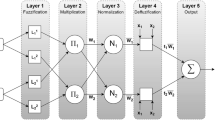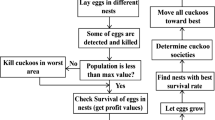Abstract
Various computational intelligence techniques have been used in the prediction of petroleum reservoir properties. However, each of them has its limitations depending on different conditions such as data size and dimensionality. Hybrid computational intelligence has been introduced as a new paradigm to complement the weaknesses of one technique with the strengths of another or others. This paper presents a computational intelligence hybrid model to overcome some of the limitations of the standalone type-2 fuzzy logic system (T2FLS) model by using a least-square-fitting-based model selection algorithm to reduce the dimensionality of the input data while selecting the best variables. This novel feature selection procedure resulted in the improvement of the performance of T2FLS whose complexity is usually increased and performance degraded with increased dimensionality of input data. The iterative least-square-fitting algorithm part of functional networks (FN) and T2FLS techniques were combined in a hybrid manner to predict the porosity and permeability of North American and Middle Eastern oil and gas reservoirs. Training and testing the T2FLS block of the hybrid model with the best and dimensionally reduced input variables caused the hybrid model to perform better with higher correlation coefficients, lower root mean square errors, and less execution times than the standalone T2FLS model. This work has demonstrated the promising capability of hybrid modelling and has given more insight into the possibility of more robust hybrid models with better functionality and capability indices.












Similar content being viewed by others
References
Jong-Se L (2005) Reservoir properties determination using fuzzy logic and neural networks from well data in offshore Korea. J Pet Sci Eng 49:182–192
Helmy T, Anifowose F, Faisal K (2010) Hybrid computational models for the characterization of oil and gas reservoirs. Int J Exp Syst Appl 37:5353–5363
Ferraz IN and Garcia CB (2005) Lithofacies recognition hybrid bench. In: Proceedings of the 5th international conference on hybrid intelligent systems, IEEEXplore/ACM digital library
Salim C (2006) A fuzzy art versus hybrid NN-HMM methods for lithology identification in the Triasic province. In: Proceedings of the 2nd international conference on information and communication technologies. IEEEXplore 1:1884–1887
Xie D, Wilkinson D, Yu T (2005) Permeability estimation using a hybrid genetic programming and fuzzy/neural inference approach. In: Proceedings of the SPE annual technical conference and exhibition, Dallas, Texas, USA
Anifowose F and Abdulraheem A (2010) Prediction of porosity and permeability of oil and gas reservoirs using hybrid computational intelligence models. Paper SPE-126649. In: Proceedings of the society of petroleum engineers North Africa technical conference and exhibition, Cairo, Egypt, February
Chang FM (2008) Characteristics analysis for small data set learning and the comparison of classification methods. In: Proceedings of the 7th WSEAS international conference on artificial intelligence, knowledge engineering and data bases, Cambridge. Kazovsky L, Borne P, Mastorakis N, Kuri-Morales A and Sakellaris I (eds) Artificial Intelligence Series. World Scientific and Engineering Academy and Society (WSEAS), Stevens Point, Wisconsin, pp 122–127
Van BV, Pelckmans K, Van HS, Suykens JA (2011) Improved performance on high-dimensional survival data by application of Survival-SVM. Bioinformatics 27(1):87–94
Mendel JM (2003) Type-2 fuzzy sets: some questions and answers. IEEE Connect Newsl IEEE Neural Netw Soc 1:10–13
Mendel JM, Robert IJ, Liu F (2006) Interval type-2 fuzzy logic systems made simple. IEEE Trans Fuzzy Syst 14(6):808–821
Peddabachigari S, Abraham A, Grosan C, Thomas J (2011) Modelling intrusion detection system using hybrid intelligent systems. J Netw Comput Appl 30:114–132
Mendoza O, Licea G, Melin P (2007) Modular neural networks and type-2 fuzzy logic for face recognition. In: Proceedings of the annual meeting of the north american fuzzy information processing society, pp 622–627
Jin B, Tang YC, Yan-Qing Z (2007) Support vector machines with genetic fuzzy feature transformation for biomedical data classification. Info Sci 177:476–489
Helmy T, Al-Harthi MM, Faheem MT (2012) Adaptive ensemble and hybrid models for classification of bioinformatics datasets. Trans Fuzzy Neural Netw Bioinform Glob J Technol Optim 3:20–29
Lean Y, Kin KL, Shouyang W (2006) Credit risk assessment with least squares fuzzy support vector machines. In: Proceedings of the 6th IEEE international conference on data mining workshops, IEEEXplore, pp 823–827
Evaggelos S, Giorgos S, Yannis A, Stefanos K (2006) Fuzzy support vector machines for image classification fusing Mpeg-7 visual descriptors. Technical Report. Image, Video and Multimedia Systems Laboratory, School of Electrical and Computer Engineering, National Technical University of Athens, Greece
Bullinaria JA, Li X (2007) An introduction to computational intelligence techniques for robot control. Ind Robot 34(4):295–302
Helmy T, Anifowose F (2010) Hybrid computational intelligence models for porosity and permeability prediction of petroleum reservoirs. Int J Comput Intell Appl 9(4):313–337
Accessscience Encyclopaedia Article (2011) Well Logging. Available online: http://www.accessscience.com/abstract.aspx?id=744100&referURL=http%3a%2f%2fwww.Accessscience.com%2fcontent.aspx%3fid%3d744100. Accessed on 28th March
Schlumberger Oil Field Glossary (2011) Porosity, Available online: http://www.glossary.oilfield.slb.com/Display.cfm?Term=porosity. Accessed on April 20
Schlumberger Oil Field Glossary (2011) Permeability, Available online: http://www.glossary.oilfield.slb.com/Display.cfm?Term=permeability. Accessed on April 20
Anifowose F (2009) Hybrid artificial intelligence models for the characterization of oil and gas reservoirs: concept, design and implementation. VDM Verlag, Germany
Singh V, Singh TN (2006) A neuro-fuzzy approach for prediction of Poisson’s ratio and young’s modulus of shale and sandstone. In: Proceedings of the 41st United States symposium on rock mechanics (USRMS), Golden Rocks
Petrus JB, Thuijsman F, Weijters AJ (1995) Artificial neural networks: an introduction to ann theory and practice. Springer, Netherlands
Anifowose F and Abdulraheem A (2010) A functional networks-type-2 fuzzy logic hybrid model for the prediction of porosity and permeability of oil and gas reservoirs. Paper #1569334237. In: Proceedings of the 2nd international conference on computational intelligence, modelling and simulation (CIMSim 2010), IEEEXplore, pp 193–198
Park HJ, Lim JS, Roh U, Kang JM, Min BH (2006) Production-system optimization of gas fields using hybrid fuzzy-genetic approach. In: Proceedings of the SPE Europec/EAGE annual conference and exhibition, Vienna, Austria
Lim J, Park H, Kim J (2006) A new neural network approach to reservoir permeability estimation from well logs. In: Proceedings of the SPE Asia pacific oil and gas conference and exhibition, Adelaide, Australia
Mohsen S, Morteza A, Ali YV (2007) Design of neural networks using genetic algorithm for the permeability estimation of the reservoir. J Pet Sci Eng 59:97–105
Zarei F, Daliri A, Alizadeh N (2008) The use of neuro-fuzzy proxy in well placement optimization. In: Proceedings of the SPE intelligent energy conference and exhibition, Amsterdam, The Netherlands
Al-Anazi A, Gates I, Azaiez J (2009) Innovative data-driven permeability prediction in a heterogeneous reservoir. In: Proceedings of the SPE EUROPEC/EAGE annual conference and exhibition, Amsterdam, The Netherlands
Shahvar MB, Kharrat R, Mahdavi R (2009) Incorporating fuzzy logic and artificial neural networks for building hydraulic unit-based model for permeability prediction of a heterogenous carbonate reservoir. In: Proceedings of the international petroleum technology conference, Doha, Qatar
Gao W (2012) Study on new improved hybrid genetic algorithm. In: Zeng D (ed) Advances in information technology and industry applications. Lecture Notes in Electrical Engineering 136, pp 505–512
Bies RR, Muldoon MF, Pollock BG, Manuck S, Smith G, Sale ME (2006) A genetic algorithm-based, hybrid machine learning approach to model selection. J Pharmacokinet Pharmacodyn 33(2):195–221
Ali L, Bordoloi S, Wardinsky SH (2008) Modelling permeability in tight gas sands using intelligence and innovative data mining techniques. In: Proceedings of the SPE annual technical conference and exhibition, Denver, Colorado
Bruen M, Yang J (2005) Functional networks in real-time flood forecasting: a novel application. Adv Water Res 28:899–909
El-Sebakhy E (2009) Software reliability identification using functional networks: a comparative study. Exp Syst Appl 36(2):4013–4020
El-Sebakhy E, Hadi AS, Kanaan FA (2007) Iterative least squares functional networks classifier. IEEE Trans Neural Netw 18(2):1–7
Castillo E, Gutiérrez JM, Hadi AS, Lacruz B (2001) Some applications of functional networks in statistics and engineering. Technometrics 43:10–24
Castillo E (2011) Software repository. Artificial Intelligence Research Group. Available online: http://ccaix3.unican.es/~AIGroup, Accessed March 25
Mendel J (2011) Matlab codes for type-2 fuzzy logic system. Accessed March 25. sipi.usc.edu/~mendel/software/
Grünwald P (2005) A tutorial introduction to the minimum description length principle. In: Grünwald P, Myung IJ, Pitt M (eds) Advances in minimum description length: theory and applications. MIT Press, Cambridge
Acknowledgments
The authors would like to thank the Universiti Malaysia Sarawak and King Fahd University of Petroleum and Minerals for providing the resources used in the conduct of this study. The authors would also like to acknowledge the support provided by King Abdulaziz City for Science and Technology (KACST) through the Science & Technology Unit at King Fahd University of Petroleum & Minerals (KFUPM) for funding this work under Project No. 08-OIL82-4 as part of the National Science, Technology and Innovation Plan.
Author information
Authors and Affiliations
Corresponding author
Rights and permissions
About this article
Cite this article
Anifowose, F., Labadin, J. & Abdulraheem, A. A least-square-driven functional networks type-2 fuzzy logic hybrid model for efficient petroleum reservoir properties prediction. Neural Comput & Applic 23 (Suppl 1), 179–190 (2013). https://doi.org/10.1007/s00521-012-1298-2
Received:
Accepted:
Published:
Issue Date:
DOI: https://doi.org/10.1007/s00521-012-1298-2




